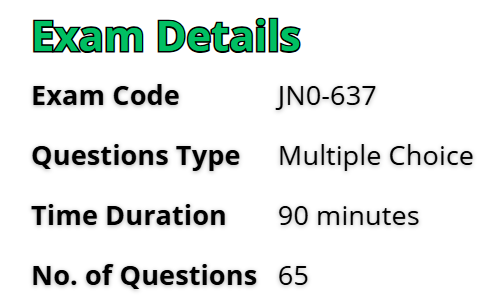JNCIP-SEC (JN0-637)

The Juniper Networks Certified Professional Security (JNCIP-SEC) certification, achieved by passing the JN0-637 exam, validates a networking professional’s advanced knowledge of security technologies and the Junos operating system (Junos OS) for Juniper Networks SRX Series firewalls. This certification demonstrates a deep understanding of security best practices, device configuration, and troubleshooting skills within a Juniper environment.
Further, this Security Track validates your expertise in security technologies and the Junos OS for SRX Series devices. JNCIP-SEC professional-level certification is intended for networking professionals with advanced proficiency in Juniper Networks’ Junos OS for SRX Series.
Target Audience
This certification is designed for experienced networking professionals who work with Juniper SRX Series firewalls and are responsible for implementing and maintaining security solutions. Ideal candidates include security engineers, network engineers, and technical staff involved in network security operations.
Knowledge Required
To succeed in the JN0-637 exam, candidates should possess a strong foundation in networking concepts and a comprehensive understanding of Juniper Networks security products. The exam covers a wide range of topics, including:
- Troubleshooting security policies and security zones
- Logical systems and tenant systems
- Layer 2 security
- Advanced Network Address Translation (NAT)
- Advanced IPsec VPNs
- Advanced policy-based routing (APBR)
- Multinode high availability (HA)
- Automated threat mitigation
In addition to technical expertise, candidates should have practical experience configuring and managing Juniper SRX Series firewalls in real-world scenarios.
Exam Details

The JNCIP-SEC (JN0-637) exam evaluates advanced security knowledge and expertise in Junos OS for SRX Series devices. The exam consists of 65 multiple-choice questions and has a duration of 90 minutes. It is delivered exclusively in English through Pearson VUE, and candidates receive their pass/fail status immediately upon completion. The exam is based on the Junos OS 22.2 and SD 22.1 software versions. To be eligible, candidates must hold the JNCIS-SEC certification. Juniper certifications remain valid for three years, after which recertification is required.
Course Outline
The JNCIP-SEC (JN0-637) exam certification exam covers the following topics:
Topic 1: Understand Troubleshooting Security Policies and Security Zones
Given a scenario, demonstrate how to troubleshoot or monitor security policies or security zones.
- Tools
- Logging or tracing
- Other outputs
Topic 2: Learn About Logical Systems and Tenant Systems
Describe the concepts, operations, or functionalities of logical systems.
- Administrative roles
- Security profiles
- Logical system communication
Describe the concepts, operations, or functionalities of tenant systems.
- Primary system and tenant system administrators
- Tenant system capacity
Topic 3: Layer 2 Security
Describe the concepts, operations, or functionalities of Layer 2 Security.
- Transparent mode
- Mixed mode
- Secure wire
- MACsec
- Ethernet VPN-Virtual Extensible LAN (EVPN-VXLAN) security
Given a scenario, demonstrate how to configure or monitor Layer 2 Security.
Topic 4: Advanced Network Address Translation (NAT)
Describe the concepts, operations, or functionalities of advanced NAT.
- Persistent NAT
- Domain Name System (DNS) doctoring
- IPv6 NAT
Given a scenario, demonstrate how to configure, troubleshoot, or monitor advanced NAT scenarios.
Topic 5: Understand Advanced IPsec VPNs
Describe the concepts, operations, or functionalities of advanced IPsec VPNs.
- Hub-and-spoke VPNs
- Public Key Infrastructure (PKI)
- Auto discovery VPNs (ADVPNs)
- Routing with IPsec
- Overlapping IP addresses
- Dynamic gateways
- IPsec Class of Service (CoS)
Given a scenario, demonstrate how to configure, troubleshoot, or monitor advanced IPsec VPNs.
Topic 6: Advanced Policy-Based Routing (APBR)
Describe the concepts, operations, or functionalities of advanced policy-based routing.
- Profiles
- Policies
- Routing instances
- APBR options
Given a scenario, demonstrate how to configure or monitor advanced policy-based routing.
Topic 7: Multinode High Availability (HA)
Describe the concepts, operations, or functionalities of multinode HA.
- Concepts
- Chassis cluster versus multinode HA
- Deployment modes
- Services redundancy group (SRG)
- Interchassis link
- Active/active mode
- Active/passive mode
- Active node behavior (determination and enforcement)
Given a scenario, demonstrate how to configure or monitor multinode HA.
Topic 8: Automated Threat Mitigation
Describe the concepts, operations, or functionalities of Automated Threat Mitigation.
- Third-party or multicloud integration
- Secure Enterprise
Exam FAQs: JNCIP-SEC (JN0-637)
Exam General Guidelines
Juniper Networks upholds high standards for JNCP certifications by implementing recertification criteria to ensure certified professionals maintain relevant skills. These criteria apply across all JNCP certification tracks and may be updated as needed. To renew a certification, candidates must either pass an exam or complete a higher-level course within the same track. This renewal extends the validity of all lower-level active certifications within the track, as well as any other active Associate-level certifications. Certification holders can monitor their status through CertMetrics and receive periodic email notifications regarding their certification status. It is their responsibility to keep both their certifications and contact details up to date. All JNCP certifications remain valid for three years, after which they will expire if not renewed within the specified timeframe.
Study Guide for JNCIP-SEC (JN0-637)

1. Understand Exam Objectives
The JNCIP-SEC (JN0-637) exam is designed for networking professionals seeking to validate their advanced expertise in Juniper Networks security technologies. To prepare for the JNCIP-SEC (JN0-637) exam, candidates should focus on mastering advanced security concepts, Junos OS configurations, and troubleshooting techniques for SRX Series devices. Key study areas include firewall security, intrusion prevention systems (IPS), VPN technologies, NAT, security policies, high availability, and advanced threat prevention. Reviewing official training materials, hands-on lab practice, and familiarizing yourself with Junos OS 22.2 and SD 22.1 are essential for success. A thorough understanding of security implementations and best practices will help ensure confident performance on the exam.
2. Utilize Recommended Training
Juniper Networks offers recommended training course to help candidates effectively prepare for the JNCIP-SEC (JN0-637) exam certification exam. This includes:
– Advanced Juniper Security
This four-day course equips students with the expertise to configure and monitor advanced Junos OS security features for enterprise, campus, and service provider environments. It covers advanced reporting, next-generation Layer 2 security, EVPN-VXLAN security, advanced policy-based routing, virtualization features, enhanced IPsec VPNs, advanced NAT capabilities, and multinode high availability. Through demonstrations and hands-on labs, participants will gain practical experience with SRX Series and vSRX Series devices. The course is based on Junos OS Release 23.2 and is also available On-Demand.
3. Use Junos TechLibrary
The Junos TechLibrary is a valuable resource for preparing for the JNCIP-SEC (JN0-637) exam, offering comprehensive documentation on Junos OS security features, configurations, and troubleshooting techniques. It provides in-depth guides, technical notes, and configuration examples covering key exam topics such as firewall policies, IPS, VPN technologies, NAT, high availability, and advanced threat prevention. Candidates can leverage the TechLibrary to gain a deeper understanding of SRX Series security implementations, explore best practices, and reinforce their knowledge through real-world use cases, ensuring a well-rounded exam preparation.
4. Join Study Groups
Participating in study groups and online forums is an effective way to enhance your JNCIP-SEC (JN0-637) exam preparation. Engaging with peers and industry experts allows you to discuss complex security topics, exchange insights, and gain different perspectives on Junos OS security features, configurations, and troubleshooting techniques. These collaborative environments help clarify doubts, reinforce learning through discussion, and provide access to additional resources such as study notes, configuration examples, and real-world implementation scenarios. Staying connected with a community of learners also keeps you motivated and updated on the latest security trends and best practices.
5. Take Practice Tests
Practice tests are a crucial part of exam preparation, helping candidates familiarize themselves with the exam format, question types, and time constraints. Taking mock exams allows you to assess your knowledge, identify weak areas, and refine your problem-solving skills. By simulating real exam conditions, practice tests improve time management and boost confidence. Reviewing incorrect answers and understanding the reasoning behind them helps reinforce concepts and ensures a deeper understanding of firewall policies, IPS, VPN technologies, NAT, high availability, and other key security features. Regular practice with sample questions and timed assessments significantly enhances your chances of success in the exam.



